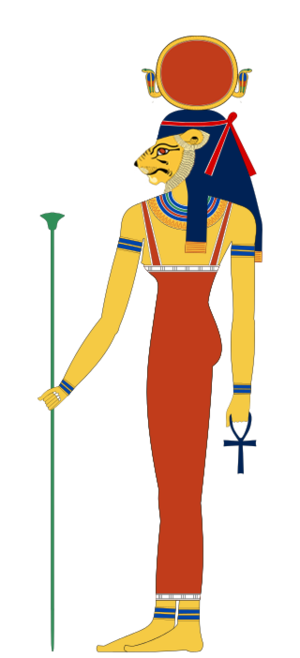テフヌト
テフヌト(Tefnut)は、エジプト神話における湿気の女神。ヘリオポリス九柱神に数えられる。テフヌト、テフヌウト、テフェネト、テフヌートなどとも表記され、ギリシア語ではトフェニスと呼ばれる。
テフヌト(古代エジプト語: tfn.t; コプト語:ⲧϥⲏⲛⲉ、tfēne)[1][2]は、古代エジプトの宗教における水分、湿った空気、露、雨の神である[3]。大気の神シューの妹及び妃であり、ゲブとヌトの母である。
目次
語源
テフヌトの名前の語源は定かではないが、創世神話でアトゥムが彼女を吐き出すように、吐き出す音のオノマトペである可能性もある。
The name Tefnut has no certain etymology but it may be an onomatopoeia of the sound of spitting, as Atum spits her out in some versions of the creation myth. Additionally, her name was written as a mouth spitting in late texts.[4]
Like most Egyptian deities, including her brother, Tefnut has no single ideograph or symbol. Her name in hieroglyphs consists of four single phonogram signs t-f-n-t. Although the n phonogram is a representation of waves on the surface of water, it was never used as an ideogram or determinative for the word water (mw), or for anything associated with water.[5]
Mythological origins
Tefnut is a daughter of the solar deity Ra-Atum. Married to her twin brother Shu, she is mother of Nut, the sky and Geb, the earth. Tefnut's grandchildren were Osiris, Isis, Set, Nephthys, and, in some versions, Horus the Elder. She was also the great-grandmother of Horus the Younger. Alongside her father, brother, children, grandchildren, and great-grandchild, she is a member of the Ennead of Heliopolis.
There are a number of variants to the myth of the creation of the twins Tefnut and Shu. In every version, Tefnut is the product of parthenogenesis, and all involve some variety of body fluid.
In the Heliopolitan creation myth, Atum sneezed to produce Tefnut and Shu.[6] Pyramid Text 527 says, "Atum was creative in that he proceeded to sneeze while in Heliopolis. And brother and sister were born - that is Shu and Tefnut."[7]
In some versions of this myth, Atum also spits out his saliva, which forms the act of procreation. This version contains a play on words, the tef sound which forms the first syllable of the name Tefnut also constitutes a word meaning "to spit" or "to expectorate".[7]
The Coffin Texts contain references to Shu being sneezed out by Atum from his nose, and Tefnut being spat out like saliva. The Bremner-Rind Papyrus and the Memphite Theology describe Atum as sneezing out saliva to form the twins.[8]
Iconography
Tefnut is a leonine deity, and appears as human with a lioness head when depicted as part of the Great Ennead of Heliopolis. The other frequent depiction is as a lioness, but Tefnut can also be depicted as fully human. In her fully or semi anthropomorphic form, she is depicted wearing a wig, topped either with a uraeus serpent, or a uraeus and solar disk, and she is sometimes depicted as a lion headed serpent. Her face is sometimes used in a double headed form with that of her brother Shu on collar counterpoises.[9]
During the 18th and 19th Dynasties, particularly during the Amarna Period, Tefnut was depicted in human form wearing a low flat headdress, topped with sprouting plants. Akhenaten's mother, Tiye was depicted wearing a similar headdress, and identifying with Hathor-Tefnut. The iconic blue crown of Nefertiti is thought by archaeologist Joyce Tyldesley to be derived from Tiye's headdress, and may indicate that she was also identifying with Tefnut.[10]
Cult centres
Heliopolis and Leontopolis (now ell el-Muqdam) were the primary cult centres. At Heliopolis, Tefnut was one of the members of that city's great Ennead,[9] and is referred to in relation to the purification of the wabet (priest) as part of the temple rite. Here she had a sanctuary called the Lower Menset.[3]
I have ascended to you
with the Great One behind me
and [my] purity before me:
I have passed by Tefnut,
even while Tefnut was purifying me,
and indeed I am a priest, the son of a priest in this temple."
___{{{author}}}
At Karnak, Tefnut formed part of the Ennead and was invoked in prayers for the health and wellbeing of the pharaoh.[11]
She was worshiped with Shu as a pair of lions in Leontopolis in the Nile Delta.[12]
Mythology
Tefnut was connected with other leonine goddesses as the Eye of Ra.[13] As a lioness she could display a wrathful aspect and is said to have escaped to Nubia in a rage, jealous of her grandchildren's higher worship. Only after receiving the title "honorable" from Thoth, did she return.[4] In the earlier Pyramid Texts she is said to produce pure waters from her vagina.[14]
As Shu had forcibly separated his son Geb from his sister-wife Nut, Geb challenged his father Shu, causing the latter to withdraw from the world. Geb, who was in love with his mother Tefnut, takes her as his chief queen-consort.[15]
External links
概要
創造神アトゥムを親に持ち、アトゥムの自慰によって生まれた(ラーと習合されたため、ラーともされる)。配偶神は兄でもある大気の神シュー。彼との間に大地の神ゲブと天空の女神ヌトを成した。雌ライオンもしくは、ライオンの頭を持った女神として描かれる。シューの妻としての伝承ばかりでテフヌト単独での伝承は、ほとんど見られない。テフヌトは天空を押し上げる夫を助け、一心同体の存在として世界の安定のために働く。
他の神々との習合
テフヌトは、シューの妻となる前に家出をしたという神話があり、宮殿で退屈していたテフヌトは父親(ここでは太陽神ラーとされる)に何も告げず、南のヌビア砂漠へ家出してしまう。獰猛な雌ライオンとなって気ままに駆け回っていたテフヌトに父親は、息子シューと知恵の神トートに依頼し、ようやく連れ戻すことに成功した、という内容である。
太陽神ラーの娘であること、雌ライオンの姿を持つことから、エジプトの女神バステトとセクメト、セクメトと同一視された女神ハトホルと同一視されることがある。
関連項目
- シュー:夫にあたる神。
- ゲブ、ヌト:子にあたる神。
- アトゥム:親にあたる神。
